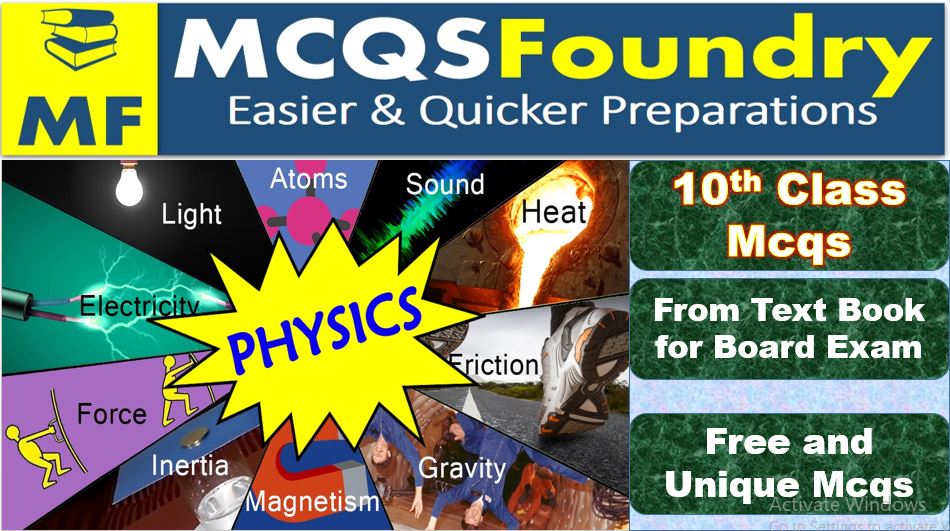
CHAPTER 18
ATOMIC AND NUCLEAR PHYSICS
(2) The mass of the proton and neutron is nearly equal to:
(4) The total number of nucleons in a nucleus is:
(6) The atomic number is represented by:
(9)Atoms of the element which have same number of protons but different number of neutrons are:
(10) Rutherford discovered that the positive charge in an atom was concentrated in a small region called
(11)are collectively called nucleons.
(12) In which simplest atom, the nucleus has only one proton?
(a) Helium
(b) Carbon
(c) Nitrogen
(d) Hydrogen
(13) In order to find the intensity of radiations, which device (s) is/are used:
(a) Film badge
(b) Dosimeter
(c) Radiometer
(d) Both a & b
(14) In nuclide 116X the number of protons are;
(a) 3
(b) 10
(c) 8
(d) 6
(15) Isotopes of an element have the same:
(a) chemical properties
(b) Atomic number
(c) Atomic mass
(d) colurs
( 16) protium & deuterium contain
(a) two protons
(b) three protons
(c) one proton
(d) no proton
(17) who accidentally discovered that uranium salt crystals emit an invisible radiation that can darken a photographic plate;
(a) Becquerel
(b) Marie Curie
(c) Pierre
(d) Rutherford
(18) Transmutation is
(a) unstable nuclei changes into stable nuclei
(b) spontaneous process
(c) a&b both
(d) non spontaneous process
(19) Gamma rays are also called:
(a) photons
( b) electrons
(c) protons
(d) positrons
(20) Which have the greatest power of ionization as compared to others?
(a) ß-particles
(b) ~-particles
(c) 7-particles
(d) x-rays
(21) Penetrating power of 7 rays as compared to a rays and 13 rays is:
(a) Greater
(b) Sinaller
(c) Equal
(d) Anyone can be
(22) The phenomenon by which radiations split water into positive an(l negative ions is called;
(a) ionization
(b) penetration
(c) sublimation
(d) deflection
(23) The rate Of radioactive decay is proportional to the number of:
(a) stable nuclei present
(b) unstable nuclei present
(c) electrons present
(d) protons present
(24) Radium-226 has a half-life of:
(a) 1820 years
(b) 1920 years
(c) 1620 years
(d) 1600 years
(25) Stable nuclei have atomic number between:
(a) I – 82
(b) 2 – 89
(c) 2 – 88
(d) 2-85
(26) Elements are naturally unstable having atomic number greater than;
(a) 84
(b) 89
(c) 82
(d) 88
(27) When two light nuclei combine to form a heavier nucleus, this process is called;
(a) Nuclear fission
(b) Nuclear fusion
(c) bombardment
(d) disintegration
(28) Which are chemical compounds containing some quantity of radioisotope?
(a) Radioactive tracer
(b) Hard compounds
(c) High energy compounds
(d) Soft compounds
(29) Which compound readily accumulates in the thyroid gland and can be used for monitoring of thyroid functioning?
(a) I – 131
(b) I – 130
(c) I – 132
(d) I – 129
(30). Which compound is used to diagnose brain tumour
(a) Phosphorus – 32
(b) iodine – 131
(c) hydrogen – 3
(d) Neon – 152
(31) Radioactive isotope is used in cancerous tumour and cells
(a) P -32
(b) I – 131
(c) C – 14
(d) Co – 60
(32) When a tree dies
(a) C -14
(b) P – 32
(c) I – 131
(d) Co – 60
(33) The half-life of C-14 is;
(a) 5720 years
(b) 5730 years
(c) 5700 years
(d) 5202 years
(34) The stable argon nuclei Ar – 40 half life?
(a) 2.4 x 108 year
(b) 2.9 x 104 year
(c) 2.5 x 109 year
(d) 2.4 x 1011 year
(35) Mass energy equation and theory of relativity was given by:
(a) Newton
(b) Quantum
(c) Einstein
(d) Volta
(36) Nuclear fission was first observed in 1939 by:
(a) Otto Hahn and Fritz Strasslnan
(b) Otto Hahn and Curie
(c) Fritz and Curie
(d) Otto Hahn and Rutherford
(37) In each fission reaction energy released;
(a) 210meV
(b) 299mV
(c) 200 MeV
(d) 255meV
(38) During fission of I kg of Uranium -235 energy released is;
(a) 67 x 1010j
(b) 65 x 108j
(c) 60 x 108j
(d) 66 x 109j
(39) Hazards of radiation for humans arc;
(a) Leukemia
(b) Sterility
(c) Blindness
(d) all given
(40) Half-life of 6027Co is
(a) 20 years
(b) 40 years
(c) 50 years
(d) 30 years
(41) The temperature of the centre of sun is;
(a) 20 million kelvin
(b) 2 million kelvin
(c) 24 million kelvin
(d) 29 million kelvin